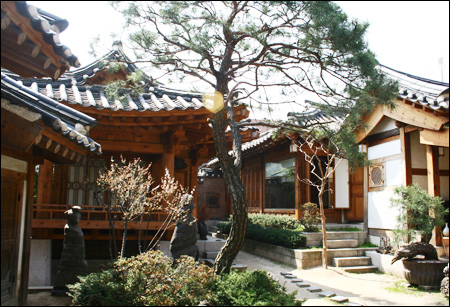David Kilburn, a free lance journalist from the U.K. who has lived in “hanok” ― traditional Korean houses ― for more than 20 years, said Seoul City is responsible for a development plan that made a lively neighborhood into a ghost town owned by land speculators.
 |
| Rakkojae, a Hanok-styled guest house in Jongno-gu, central Seoul / Korea Times |
He made the remark Thursday during a forum to discuss the future of hanok.
Kilburn is known for his love for the traditional houses and even lost his eyesight during a long struggle to protect them.
“When we first went to live in Gahoi-dong in 1988, there were about 1,500 hanok in Bukchon. Today there are only about 900, and the number keeps falling,” Kilburn said.
“Only a week ago, another hanok on our own street in Kahoi-dong was demolished. Ours is now the only original building left.”
Seoul City is directly responsible for the reduction in the number of hanok during a period in which they claim to have had preservation policies, he said.
He claims that although the city used the term “protection and conservation,” the implementation of the plan was similar to a typical urban redevelopment project. “Old buildings were bulldozed to make way for modern ones,” Kilburn said.
He said the area in Gahoi-dong where he lives was one of the most well-preserved areas of hanok but the Bukchon Plan changed all that.
“Many owners were given grants for the restoration of existing hanok and allowed to use the money for demolition. Some residents were intimidated into selling their hanok,” he said.
“City authorities, the police, the prosecutors, the courts all declined to take action when confronted with evidence of these abuses.”
In addition to Kilburn’s speech, professor Kim Do-kyong of Kangwon National University led the discussion by explaining the current status of hanok preservation polices and development plans. This included issues such as protection of the rights of hanok occupants during redevelopment process and the need for a special law protecting and promoting traditional Korean houses.
Professor Kim said there is a need for more research on hanok to optimize them for today’s society.
“For instance, hanok are built from natural materials such as wood, stone and earth. However, it is hard to construct with such materials nowadays and we have to find alternatives, without harming the spirit of them,” he said.
Kim Jin-ai, a lawmaker of the opposition Democratic Party and an architect, hosted the discussion.
“Hanok have historical significance as traditional architecture. The laws should be revised to preserve and develop the architectural and cultural value of hanok,” Kim said. “The government should come up with a support policy to inherit the tradition.”
meeyoo@koreatimes.co.kr